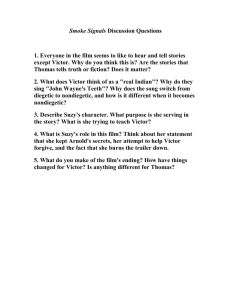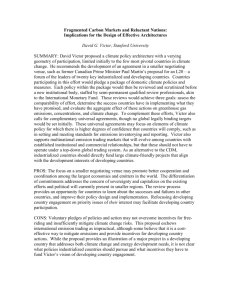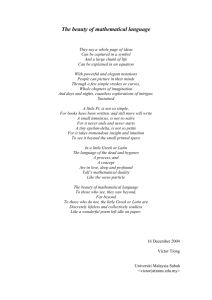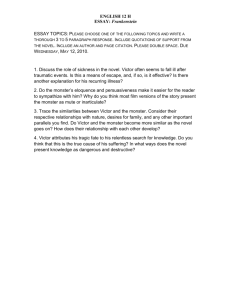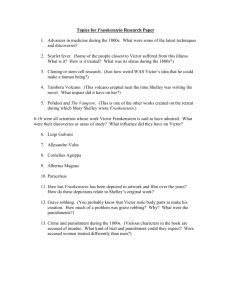Sophie Mire - Furman University
advertisement
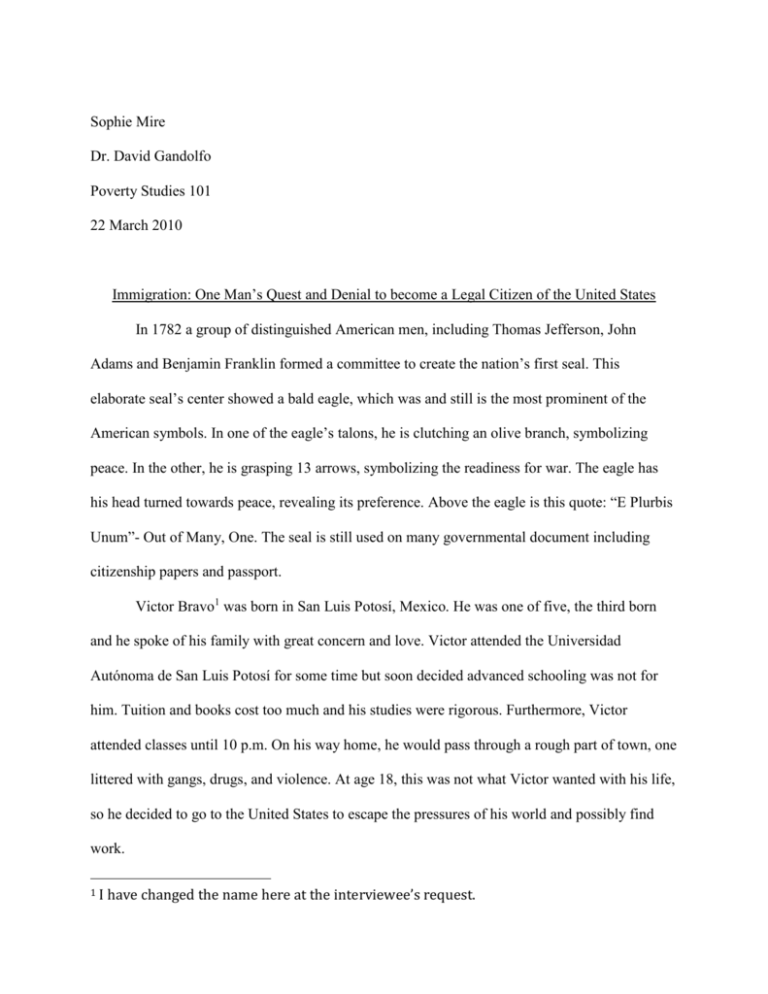
Sophie Mire Dr. David Gandolfo Poverty Studies 101 22 March 2010 Immigration: One Man’s Quest and Denial to become a Legal Citizen of the United States In 1782 a group of distinguished American men, including Thomas Jefferson, John Adams and Benjamin Franklin formed a committee to create the nation’s first seal. This elaborate seal’s center showed a bald eagle, which was and still is the most prominent of the American symbols. In one of the eagle’s talons, he is clutching an olive branch, symbolizing peace. In the other, he is grasping 13 arrows, symbolizing the readiness for war. The eagle has his head turned towards peace, revealing its preference. Above the eagle is this quote: “E Plurbis Unum”- Out of Many, One. The seal is still used on many governmental document including citizenship papers and passport. Victor Bravo1 was born in San Luis Potosí, Mexico. He was one of five, the third born and he spoke of his family with great concern and love. Victor attended the Universidad Autónoma de San Luis Potosí for some time but soon decided advanced schooling was not for him. Tuition and books cost too much and his studies were rigorous. Furthermore, Victor attended classes until 10 p.m. On his way home, he would pass through a rough part of town, one littered with gangs, drugs, and violence. At age 18, this was not what Victor wanted with his life, so he decided to go to the United States to escape the pressures of his world and possibly find work. 1 I have changed the name here at the interviewee’s request. 2 It was June of 1989, and Victor and a friend, Ricardo2, moved into his Victor’s brother’s house in Tijuana, on the border. Leaving Tijuana, it was only about a mile run to the United States. Victor and Ricardo ran the mile and then hopped a six-foot high wire fence. During those days, according to Victor, “people didn’t care as much. You could just say ‘I’m an American citizen or have an English speak with you to verbalize it for you”. Victor, at this point, needed that English -speaking companion- Ricardo. After crossing, a prearranged van picked the two men up and drove them twenty miles north to San Diego. The driver charged him $300.00, which at the time was quite steep. He stayed in San Diego, except for one trip to Los Angeles to obtain a fake green card and a fake social security card. By word of mouth, one can easily obtain fake papers. Victor called them “mafia” men who worked in shady cover up businesses. They were sometimes legal or illegal Hispanic men selling to help out a fellow Hispanics. If not that, then they were American citizens selling fake documentation at a jacked up rate. Victor bought his from the latter. “One just needs to know the right people”. These falsified documents set Victor back $120.00. According to Victor, the papers did not look that legitimate but they were better than nothing. Employers knew the papers were fake; it was merely a formality. If the INS came knocking, the employers could say that they checked the papers and they looked legitimate. It was not as if the average business owner was an expert at sighting counterfeits. Outside of San Diego, Victor found some work- mostly landscaping and construction. Three months later, luck stroke. Upon hearing that an employee was needed at a local nursing home, Victor interviewed and secured the job. Working as a janitor in a nursing home was not easy. Victor said that the nursing home was the first place where he’d really seen racial diversity. 2 I have changed the name here for protection 3 White, Blacks, Asians, and Europeans all resided in the nursing home, all walks of life, except for Hispanics. He felt out of place amidst a sea of judgment. As Victor swept and mopped the hallways, the older ladies would yell at him from their beds. They would critique his work and yell out racial slurs. One senile woman would call him a “beaner”, a derogatory term referring to Mexican frijoles or beans. Victor did not take it too personally. He said that they were just old and crabby. After some time, Victor decided to take initiative and befriend them. He would go in to work earlier, perform his duties, and then spend time with the patients, sitting, listening and talking. This is how Victor learned English fluently. The older women soon loved Victor, and only Victor. He was their favorite employee. The manager of the nursing home, Daniel, saw something special in Victor, only 21 years old at the time. He had a work ethic second to none and was as compassionate as anyone Daniel had ever met. One of the more common misconceptions that counter character about immigrants is that they are lazy. There was a study done by the University of Tennessee in which work ethics across different populations were examined. The study was a cross sectional comparison using mathematical models. The researchers developed a model called the Multidimensional Work Ethic Profile (MWEP). This model was used to analyze and then compare two populationsMexicans and Americans. Work ethic was deemed as (a) multidimensional; (b) pertaining to work and work related activities-school hobbies, etc); (c) is learned; (d) refers to attitudes and beliefs (not necessarily behavior); (e) is a motivational construct reflected in behavior; and (e) is secular, not necessarily tied to any one set of religious beliefs (Examining Work Value Across Populations 2002). Based on all of this and the mathematical model, it was concluded that there is very little differences in the work ethics between Americans and Mexicans. However, there was less deviation among the Mexican population and a larger spectrum of work ethic among the Americans. In other words, there were more “lazy” and “hard working” Americans, whereas the 4 Mexican population looked seemingly uniform. For this reason, the myth perpetuates. Even so, Victor was a hard worker, as documented by his employers and friends. Another one of the very common stereotypes that again opposes character and moral behavior among Hispanic illegals is their criminal behavior. A very small number of immigrants are drug dealers, thieves, pimps, or even in jail. Far more Americans occupy our jails than illegal persons. “Among men age 18-39 (who comprise the vast majority of the prison population), the 3.5 percent incarceration rate of the native-born in 2000 was 5 times higher than the 0.7 percent incarceration rate of the foreign-born” (Equal Rights Center, 2008) According to some the misconceptions, if they are not in jail they are impregnating multiple women and having dozens of children. According to the CIA World Fact Book, the average Mexican immigrant to the United States (male or female) has 3.1 children. In 2002, the average American family had 2.4 children. In Niger, a country in Africa, the average number of children per household was 7.75 (2008). After seven months working at the nursing home, Victor had saved up quite a bit and decided to purchase a car. The Toyota Celica GT stick shift with a crank sunroof was Victor’s first car. It was January of the next year and he hadn’t seen his family in seven months. Victor took off a week’s time and it was well deserved for he hadn’t missed a single day in seven months, according to Daniel. Eager to return to Mexico, Victor and a legal friend drove the car back across the border. Having a legal friend drive the car across the border while Victor rode passenger would be much less conspicuous. “They do not question Mexicans going back to Mexico, only Mexicans going into the United States”. Victor ended up staying for a longer time than anticipated. Furthermore, it was a celebratory time as it was the city’s festival of the patron saint- all the more reason to 5 return. He stayed two weeks and feared that he had lost his job. Still, he knew he had to go back to at least check. Leaving the car behind as a gift for his family, he again decided to cross. The details of this trip across the desert are much fuzzier. Victor remembers walking in the bushes for four hours during the night. Once he crossed the border a car picked him up and drove him to San Diego before driving to San Francisco. They had to stop in San Bernardino because there was a second checkpoint searching for undocumented persons. This search was a little trickier. The passengers in the car were the driver-a legal Hispanic man, his pregnant wife, and two children. Victor was told to pretend to be part of the family. At the checkpoint, the driver handed over his papers and there were no further questions asked. For this ride, it cost him another $300.00. Once he returned his job was still waiting for him. Daniel told him other men came and applied for his job, but he knew that Victor would return and furthermore nobody was better than Victor. Over the next ten years, Victor would build a life with a fellow immigrant worker whom he met in the nursing home, a woman from Nicaragua named Elaine3. Elaine was however documented. She arrived from Nicaragua in the early 1980 when she crossed the border illegally. She rafted and swam across the Rio Grande into Texas. After crossing she obtained residence on the grounds of political asylum, fleeing the Sandinistas. The two sharing a common past of uprooting and resettling, would expand to a family of five, three boys- Jesus, Nestor, and Waltercito. Elaine’s family had relocated from California to Knoxville, Tennessee and Victor, wanting his children to know their grandparents and uncles I have changed the woman’s name here. Elaine was however documented. She had a green card. For the remaineder of this paper, I will refer to her as Victor’s wife. Even though they were never officially married, they presented themselves as a married couple. In the state of California, this would also quantify as a common law marriage. 3 6 and aunts, obliged to moving across the country. This meant that it would be much harder to return to Mexico, if ever. Victor did not like the South. Life here was much different. He missed the people and the life of a big city. The South was hard to navigate. Driving here was much more difficult as there were more mountains, hills, and valleys. However, Victor saw the good. The education system was better, and there were less gangs and drugs. Also, there was a smaller Hispanic population; which in turn meant more community building and probably a better chance at achieving citizenship. There would be less competition if he were to try to get citizenship. Upon arriving in Knoxville, Victor mad a very risky move. He took counterfeit fake Social Security card to the Social Security office downtown. He walked in and told the officer that he thought his card might be a fake. Looking at the card, the officer said yes it was illegitimate. The officer ran the number and it belonged to someone else. He then ran Victor’s name in the system and it appeared as a valid name. Apparently, Victor’s mafia men had put his name into the system so that he appeared to be a citizen. Victor, unbeknownst to this, did not fully understand the ramifications of this. The only reason he wanted a social security card was to secure work with a reasonable pay in order to support his family of five. The officer issued Victor a brand new legitimate card for $12.00. Victor could “legally” secure work. To anyone in the workforce, Victor was a legal citizen. This opened up hundreds of new doors. He could get a driver’s license, open a banking account, and broaden his work clientele. The only thing that was missing was a valid passport. He probably could have applied for a passport, but it would be a riskier endeavor than applying for other governmental services like a driver’s license. The industry for document fraud is highly lucrative. According to 2009 Identity Theft statistics, there are 210,000 American victims yearly. The average cost of fake papers is $165.00 7 per type of documentation. Most people purchase a driver’s license, birth certificates and a social security card (www.spendonlife.com). A rough estimate would be that this manufacturing is easily a billion dollar industry. Other documents that are frequently fraudulent are baptismal certificates, marriage licenses, and passports. The Social Security Association puts in various “safeguards” to prevent or at least recognize fake papers. “The SSA provides its employees with copies of a guide prepared by the Immigration and Naturalization Services (INS) that highlights what to look for when inspecting documents” (Dinerstein 2002). This guide is the main source for field offices. Although the SSA provides the guides, it does not enforce the reading or require testing on the material. Fake papers could easily go through undetected, much like Victor’s did. Victor’s mother in law had secured a job as a full time nanny to a woman named Cindy and she brought Victor along one day to do some handiwork. An older woman ran the house, Cindy’s mother and her name was Sittie- Arabic for grandmother- and that is what he called her. She took a liking to Victor’s honesty and hard work and she kept giving him more and more responsibilities. Victor became very skilled. He could place tile, run electricity, plumbing, roofing, lay carpet, paint and even took a liking to auto mechanics. Sittie found him jobs all over the city among her church friends, and they paid him an honest wage. Every time he mastered a new skill, his wage would increase until it was $20.00 an hour, which was far above the average hourly wage of illegal immigrants at $5.45 (Federation for American Immigration Reform, 1992). Victor could steadily provide for his family. One day, Victor was working hard and Sittie asked him to sit down with her and have a talk over some lemonade. She told him that he needed to become a citizen- do the “right thing”. Victor said he would give it some thought. He even went and spoke to his priest, Father David. Victor went to him and asked him if it would be morally permissible to marry Elaine in the 8 church. The priest said no because it would be using Elaine for her citizenship status. Victor then asked him if he should apply for citizenship. Father said, “Do not do it. You’ll never get it [citizenship]. They system will take advantage of you”. Sittie passed away on Christmas day 1999. As Victor spoke of her, he began to tear up. Even though he called her “grandmother”, she really served him as an aunt, Victor said. Victor even served as a pallbearer at her funeral. After her death, Victor decided to “do right thing” and seek legal status. By obtaining this status he could apply for a passport and travel back and forth to see his family in Mexico. He could take his boys to meet their abuelos. The United States publishes a “Guide to Naturalization” which is supposed to provide all of the necessary information one should need in seeking legalization. According to the welcome paragraph of the “Guide”, “immigrants have come here seeking a better way of life and have strengthened our Nation in the process” (1). While they may be “strengthening the Nation”, there are reasons to doubt the nation’s acceptance of their strengths as warm and amicable. The first pages are frequently asked questions with wordy sentences that have to be reread over and over in order to comprehend. The first step is to read the guide from front to back and then proceed. If successful, 26 steps later citizenship is secured. There are Spanish versions but if you are illiterate, there is no other option. You would have to have someone read it to you and make sure you understood all of the steps necessary. It would be easy to wreck. Amidst those steps include multiple applications, fingerprinting, interviews, civics tests, English tests, oaths, and astronomical fees. The civics test was revamped on October 1, 2009 during the tail end of the Bush administration. These revisions were the first since 1986. The test added more detail specific question with the goal of ensuring that new citizens really knew their American history. The test, 9 for example, asks relatively easy questions such as the colors and detail of the American flag. Medium questions might be surrounding the U.S.’s government. An example might be, “Name the three branches of government and their roles”. The hardest of questions might be something like, “Who is the Supreme Court Justice?” Ironically, many of the questions have to deal with the pilgrims- immigrants- and why they came to a new land. The Goldwater Institute tested the civics intelligence of 1,350 Arizona high school students in February 2010. The 10-question quiz was a mini replication of the U.S. Citizenship Test administered by the U.S. Citizenship and Immigration Services. The results yielded an unfortunate response. Out of the 1,134 Arizona public school students who completed the survey, ‘not a single one correctly answered more than seven [questions] correctly,’ according to the Goldwater Institute. Arizona high school students were recorded at a failure rate far exceeding 96 percent. (Tanabe 2010) The fee for filing an application is just under $600.00, which is risky given that you could be rejected. If you are denied you must wait five years to reapply and must pay again. Additionally, a fee of $80.00 is due for fingerprinting. Governmental websites also sell items from online immigration guides to civics study guides that cost $49.95 each. Furthermore, any payment must be made in the form of a check or money order. This does not seem unreasonable, but in order to have a checking account, one must have a social security card. To have a social security card, one must be a legal citizen. The only option is to find someone who has a checking account to write it for you, or to purchase fake papers and hope you do not get caught. It does not make sense (Guide to Naturalization, 2006). To avoid all of the paperwork, hassle, and bureaucracy, a lawyer in Knoxville told Victor of an alternative. He would need to go to California to open up his citizenship request. Because that was the main point of entry, he would be best off seeking it from there. Victor drove cross- 10 country to meet with this immigration lawyer. The lawyer told him that she would open his case, but it would cost him $4500.00. At their first appointment, she told him that he would apply for political asylum, even though Victor did not come from a politically torn country. This declared intention would then be automatically transferred to Tennessee because it was his home state. Political asylum is "unable or unwilling to return because of persecution or a wellfounded fear of persecution on account of race, religion, nationality, membership in a particular social group, or political opinion" (Campbell, 2007). Victor clearly did not qualify for this. He had received ill advice from an American trained lawyer. Once back in Tennessee, Victor hired a second lawyer, Rehim Baba4, from Memphis and paid him a second $4500.00. Baba secured a court date and Victor’s family and Cindy attended. At the first trial in Memphis, the lawyer came underprepared. Baba arrived and asked Elaine for Victor’s tax returns. Elaine claimed that she only had some of them and the rest were at home. Additionally, the paperwork was incomplete and scattered. Furthermore, Victor, Elaine, and Cindy did not know that they were needed. They maintain that they were never told this. The lawyer the proceeded to call Elaine, Victor, and Cindy liars. After hearing the case, the judge claimed that he was infuriated that someone would claim political asylum when that was not the case. Baba never explained that Victor had done this at the advice of another lawyer. The other attorney then discovered that in one of the tax returns, Elaine has foolishly and irresponsibly claimed an additional dependent child in Nicaragua because she was financially supporting her. The attorney representing the state jumped on this. He claimed that Victor, not Elaine, was trying to cheat the system. The attorney also said that the two were not married and were filing jointly- this was poor character. Lastly, 4 I have changed the name of the lawyer here. 11 all of this was translated from Spanish to English. The judge ridiculed Victor for not being able to speak English, even though Victor could do so. Baba did not even know that Victor was fluent in English. The judge ruled that Victor did not qualify for residence because of his poor character and unwillingness to assimilate into American culture, so he was left with the verdict of voluntary departure. Victor was devastated. He did not want to bring his children because they were in better schools than they would be in Mexico. The children were American citizens. He would have to get visas and passports for them before he left- in one week. They had been born in the United States and furthermore, they did not speak Spanish. To move them would not have been in their best interest. The judge told Victor, in a condescending tone, to take his girlfriend with him however Elaine had a green card. Leaving the United States would ruin her residence status and leave her separate from her family. Crying Victor drove to the lawyer’s office and delivered the second portion ($2500) of the payment. The lawyer claimed that he was sorry. Voluntary departure permits an individual to leave the country at his or her own expense by a certain deadline in order to avoid forceful removal. The departing individual may not reenter for up to ten years and if he or she does, civil and criminal penalties may arise. Victor returned to Mexico without his wife and children. Once he reached home, he learned that his father had passed away just 24 hours prior. Victor said that once in Mexico, he visited his father’s grave daily. He would kneel down, cry, apologize for not being able to see him sooner, and hoping that it would not be the same for his sons. He wanted to be there for his sons; unlike he was for his father- of course not by his own choice. 12 From Mexico, Victor appealed the court’s decision. He also filed a complaint on the former lawyer, and sought new counsel, which he found in the charismatic Blake Carlton5. Carlton, an attorney from Atlanta, put all his energy into this case. Additionally, he was highly sought after because President Bush appointed him to head immigration reform. Carlton requested local businesses and professionals in Knoxville to write letters of recommendation and endorsement on Victor’s behalf. Letters came from former employers, doctors, and his sons’ teachers and scoutmasters. One of the fourteen letters was from his former employer. He called Victor, “a highly skilled carpenter… and if he were legal he would be making close to $100,000.00 a year”. Another letter arrived from a psychologist from Athens, TN who wrote that Victor’s departure would be an extreme hardship for his family. Carlton also requested that Victor get all his taxes fully in order-, which was hard to do from Mexico. Cindy worked extensively on this, fixing all of Elaine’s errors. When all the taxes were in order a year later, Cindy found a letter from the IRS claiming that they had frozen Victor’s tax returns that year until he could prove the legal dependent. Had they had this letter at the trial, it would have refuted the other attorney’s claim that he was stealing from the government by filing incorrectly. The psychologist was unfortunately right. His three boys began acting out in school. Fighting soon followed and their perfect attendance disappeared. Prior to his removal, the boys were deeply involved with a variety extracurricular activities- from football to boy scouts. This all vanished with Victor’s departure. His wife, Elaine, suffered an extreme mental hardship, contemplating suicide. Without Victor, the family had no source of income and soon fell below the poverty line. The children went on TennCare, Tennessee’s Medicaid program for children below the poverty line and Elaine went on Medicare. U.S. born children to immigrants are 5 I have changed the name of the lawyer here. 13 eligible for such government programs and immigrants of political asylum have access to it as well. The case was ultimately taken to Cincinnati. Three judges reviewed the case and left the courtroom to deliberate. Three hours later they returned. They explained that they had a very hard time with this case. One of the judges said that Victor had outstanding moral character and he could see the impact of his absence on the family. However, he said that the judges decided they could not overturn the decision of another judge. The verdict stuck. It was unbearable to be apart from his family. Victor’s sons would call and beg him to return home. It was a miserable situation. Victor could not handle it anymore. He decided he had to re-cross and reunite with this family. This third journey was much more difficult. Twenty years later, Victor was not in the shape he had been the first few times he crossed. According to the ACLU, “6000 people died trying to cross the border into the U.S in the last fifteen years” (Democratic Underground, 2005). Everyday approximately 3000 immigrants are caught trying to cross the border, with 800 making it across (Mexican Immigration to the United States). This would not be an easy task. Victor’s sister found a coyote and Victor hired him to take him across the border. Victor flew from Mexico City to the Mexican state of Sonora, where he met up with the coyotes. Once in the state of Sonora, the coyotes drove him and 25 others to a small house on the border. Because they were such a large group, the coyotes told them they would be making two separate trips. All off the people slept in the same room in homemade bunk beds, four beds high. All the other groups were families; Victor was the only solo traveler so he had to go the second day. 14 Victor said it was extremely cold that night, even though he wore a two pairs of pants, a sweater and a jacket. He also carried trash bags on him in case he had to cover up under them and pretend to be trash when helicopters flew over. Sonora is an interesting state because of the temperature variability. Some seasons are as cold as 32 degrees at night while other areas can reach 132 degrees. (Climate of the Sonoran Desert, 2002) The travelers would huddle together to keep warm. A family offered Victor to huddle with them because he was alone. The second group began walking between three and four in the morning. One coyote walked in front leading the way and another brought up the rear. After a few hours of walking, an older woman began to fall behind. The coyotes said it was too risky to keep walking at her pace. They said they would leave her or she could walk back by herself, but they would not jeopardize the whole group getting caught. Victor protested and said he would carry her. He carried her on his back for hours while still carrying his two jugs of water as well as hers. Victor said he thought he was going to die in the heat, for the temperature had risen to the high 90s. The group periodically took five-minute breaks and at two in the afternoon, they took an hour break. During this break, a helicopter flew overhead. Victor hid under his trash bags and the helicopter just missed them. The group continued to walk until eight in the evening. They had traveled more than fifty miles in total and had walked over 18 hours. Victor had carried a woman and four water jugs plus his own belongings. He said he was the slowest of everyone and he had extreme leg cramps. He had finished his water two hours prior to the end of the trip and he was so thirsty. He had stripped down to a single pair of pants and a t -shirt. They had crossed the desert and climbed multiple burning hot metal fences. 15 The group finally reached a small road on the edge of a town on the Arizonan border. The coyotes made a phone call and two trucks came and picked them up. The driver packed twelve into a van and drove as fast as they could (over 100 mph) to a small house in Phoenix. The next day they were taken to Los Angeles by another van. In the van was Victor, a pregnant woman, her husband and two small children. The driver and the copilot were doing cocaine lines the whole time. Victor wanted to say something but he didn’t want to jeopardize being thrown out. Once in Los Angeles, he was passed off to another driver who drove him down to San Diego. Victor met up with another sister who lived in there for about an hour. She gave him fresh clothes. The driver told him they had to go and he took Victor to another house nearby to spend the night. The people how lived in the house told Victor he could not sleep in the house or shower, he had to sleep outside. The next day Victor was taken to a “Mexican restaurant” in San Diego that secretly served as a underground transportation hub service for immigrants. He went inside and met other immigrants who all appeared to be customers eating at this Mexican restaurant. This was the first meal he had had in 3 days. Victor went to the bathroom and cleaned off as much as he could. The drivers told him to go wait in the van for them. Eight hours of waiting finally paid off and Victor was driven to another site where he was told to switch vans. He got into a Toyota Sienna and finally they were off to the East Coast. Victor sat in the truck from San Diego to Nashville because it was so crowded. Victor was so excited when he got to Nashville; he was only two hours from Knoxville, from his boys. The driver then informed him that he had to drive to Ohio before he would drive to Knoxville. Eight hours later, he made it to Knoxville and was reunited with his children. The whole trip 16 cost $1200.00. The hell was over for now. Victor would have to remain undercover for ten years before he could even apply for citizenship again. I asked him if he would try again for citizenship. He replied, “Of course”. “E Plurbis Unum” or “Out of Many, One” truly symbolizes the struggle that many immigrants face. The United States prides itself on it is mixing pot status, accepting all kinds and recognizing their value to society. Just as the preamble says, “immigrants have come her seeking a better way of life” America’s forefathers dared to cross the dangerous Atlantic Ocean in order to seek a better way of life. Immigrants of Mexico do the same. They come by boat or by desert and some survive, but many do not. Eventually out of a grueling process, out of many, one may become a citizen but Victor was not that one. Someone else was and maybe he or she was more deserving. But maybe not. 17 Works Cited Bravo, Victor. (Personal Communication, March 12, 2010) Campbell, Boyd. “Qualifying for Political Asylum in the United States” Retrieved from http://www.visaus.com/asylum.html CIA World Fact Book. Retrieved from https://www.cia.gov/library/publications/the-worldfactbook/ Climate of the Sonoran Desert. (2002,October). Retrieved http://alic.arid.arizona.edu/sonoran/Physical/climate.html Democratic Underground. (2009, October). Retrieved from http://www.democraticunderground.com/discuss/duboard.php?az=view_all&address=102 x4084581 Dinerstein, Marti. Center for Immigration Studies. “America’s Identity Crisis: Document Fraud Is Pervasive and Pernicious”. Retrieved from http://www.cis.org/articles/2002/back302.html Equal Rights Center. (2008, August). 10 Harmful Misconceptions About Immigration. Retrieved from http://www.equalrightscenter.org/publications/documents/PrintReport_001.pdf Federation for American Immigration Reform. (1992, March). Characteristics of the Illegal Alien Population. Retrieved from http://www.fairus.org/site/PageServer?pagename=iic_immigrationissuecentersdfe9 Mexican Immigration to the United States. Retrieved from http://www.ackland.org/education/k12/handoutpdfs/Mexico.pdf Tanabe, Morgan. State Press.com. U.S. Students Fail Citizenship Test. Retrieved from http://www.statepress.com/2010/03/04/u-s-students-fail-citizenship-test/ 18 U.S. Citizenship and Immigration Services. (2006, June 15). A Guide to Naturalization [Pamphlet]. Retrieved from http://www.uscis.gov/files/article/M-476.pdf Woehr, David. (2002) Examining Work Values Across Populations: A Comparison of the Multidimensional Work Ethic Profile Across Three Diverse Cultures. Retrieved from http://epm.sagepub.com/cgi/content/abstract/67/1/154 2009 Identity Theft Statistics. Retrieved from http://www.spendonlife.com/guide/2009-identitytheft-statistics
